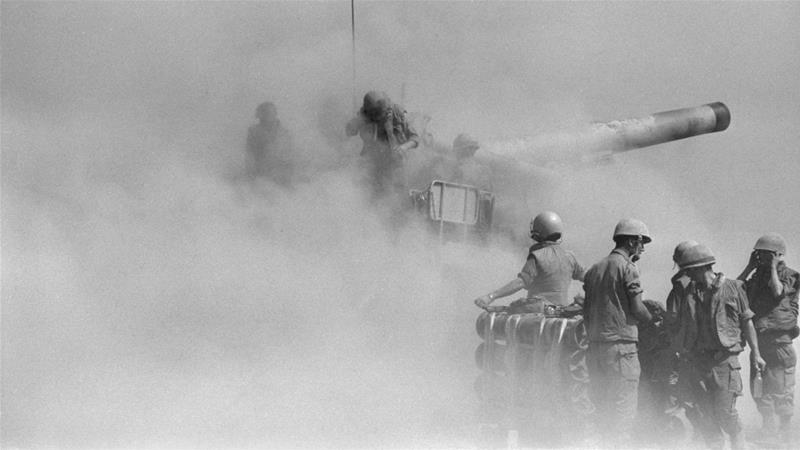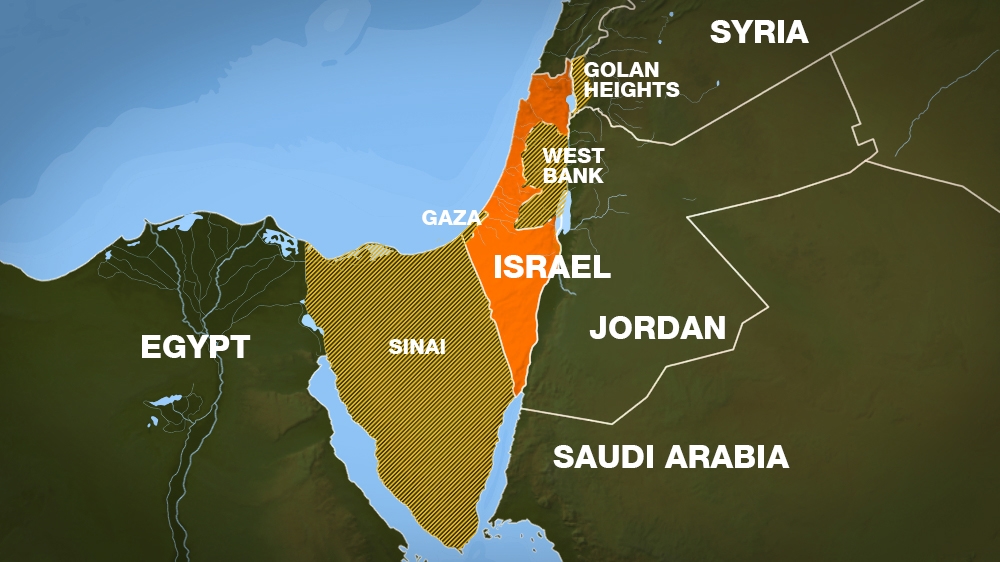The October Arab-Israeli War of 1973: What Happened?
HISTORY, MIDDLE EAST AND NORTH AFRICA, PALESTINE ISRAEL GAZA GENOCIDE, 9 Oct 2017
Al Jazeera – TRANSCEND Media Service
Forty-four years since the October war in 1973, Israel still occupies Palestinian territories and Syrian Golan Heights.

To catch Israel off guard, the Egyptians and Syrians decided to launch an attack on the Yom Kippur religious holiday. [Getty images]
6 Oct 2017 – It has been 44 years since the start of the 1973 War between Israel, Egypt and Syria.
The war, known to Israelis as the Yom Kippur War, ushered in a new reality in the Arab world and changed the face of US foreign policy towards the Middle East.
Here’s a breakdown of what happened:
Why did the three countries go to war?
The conditions that shaped the 1973 War were established six years prior.
In 1967, Egypt, Jordan, Syria engaged in six days of battle against Israel that resulted in the Israeli occupation of what remained of historic Palestine, as well as the Egyptian Sinai desert, and the Golan Heights from Syria. The event came to be known as the June War.
In a matter of six days, the Israeli army delivered a huge setback to the forces of three Arab countries and gained territory that was three and a half times its size.
Fast-forward six years, Egypt and Syria decided to launch a two-front coordinated attack to regain the territory they lost in 1967.
In the background, the politics of the Cold War between the Soviets – who supplied the Arab countries with weapons – and the US – which backed Israel – played out and inflamed the war, bringing the two blocs to the brink of military conflict for the first time since the 1962 Cuban Missile Crisis.
Under Egyptian and Syrian former presidents Anwar Sadat and Hafez al-Assad, the two Arab nations concluded a secret agreement in January 1973 to unify their armies under one command.
How did the war unfold?
To catch Israel off guard, the Egyptians and Syrians decided to launch an attack on the Yom Kippur religious holiday, the only day in the year in which there are no radio or television broadcasts, shops close and transportation shuts down as part of religious observations.
The holiday fell on Saturday, October 6, 1973, and just after 2pm, the Egyptian and Syrian armies, with advanced Soviet weapons, launched a two-front offensive on Israel, from the north and the south.
Under “Operation Badr” the Egyptian military forces managed to cross the Suez Canal and capture the Bar Lev Line – a fortified sand wall on the east bank of the canal.
This initial military success, which came to be known to Egyptians as “the crossing,” served as a sign of victory after 25 years of defeat.
On the northern front line, Syrian tanks penetrated Israeli positions and swept across the Golan Heights.
The Israeli losses were heavy, much of the territory had been retrieved, and the course of the war seemed to lay squarely within Arab hands.
Within the first two days, the Israeli army formulated a new strategy and went on the offensive, deciding first to tackle the Syrians in the north. As a result, units from the Iraqi, Saudi and Jordanian armies joined the fight on the Syrian front to face the counterattack.
Both the USSR and the Americans began airlifting arms, including tanks and artillery, to their allies as their stockpiles began to ran out.
On October 16, 10 days after the start of the war, Israeli forces, under the command of Ariel Sharon, managed to penetrate Egyptian and Syrian defence lines and came within a shocking distance from Cairo, the Egyptian capital city.
READ MORE: The 1967 war: How Israel occupied the whole of Palestine
The counterattack majorly turned the tide of the war in favour of the Israelis, and the fighting came to a stalemate.
On October 17, the Arabs decided to use a different tactic – oil. The Arab oil-producing countries, under the Organisation of Petroleum Exporting Countries (OPEC), decided to reduce their oil production by five percent.
They pledged to “maintain the same rate of reduction each month thereafter until the Israeli forces are fully withdrawn from all Arab territories occupied during the June 1967 War, and the legitimate rights of the Palestinian people are restored”.
The Arab countries enforced an embargo on the US, suspending oil supply.
The reduction in oil production and supply led to major price hikes around the world, causing the US to reassess its support for the war.
Diplomatic track
By the last week of October, the two sides were ready and willing to accept a ceasefire deal.
Estimates put the number of Israeli soldiers killed at 2,600 and 8,800 wounded, significantly larger in proportion compared with the Israeli population at the time, while Egypt was reported to have lost 7,700 men and Syria some 3,500.
On October 22, the UN Security Council passed Resolution 338, which called for a ceasefire and reaffirmed Resolution 242 passed in 1967, which called on Israel to withdraw from the territories it occupied in 1967.
The US then began intensive diplomatic efforts to secure disengagement agreements between Israel, Syria and Egypt, and offered them millions of dollars to reach such deals.
By May 1974, agreements were struck between the three countries. Egypt and Syria regained a portion of their territory and UN buffer zones were established between them and Israel.
Aftermath of the war
Both the Arabs and Israel declared victory in the war. The Arab countries managed to salvage their dignity after repeated losses in the 1948, 1956 and 1967 wars with Israel.
Within four years, in 1977, Sadat was in Jerusalem giving a speech of peace to the Israeli parliament, the Knesset.
Then US President Jimmy Carter invited both Sadat and former Israeli Prime Minister Menachem Begin to Camp David, a country retreat for the US president near Washington, DC.
The three leaders engaged in secret discussions over 13 days, leading to the signing of the Camp David Accords on September 17, 1978, which laid out conditions for an Egyptian-Israeli peace treaty, and a framework for Israeli-Palestinian peace using Resolution 242.
While the Egyptian-Israeli peace treaty was signed by March 1979 in Washington, DC, the framework never materialised for several reasons, although both sides laid blame on one another. The proposal was vague on the subject of Palestinian refugees, and the key issue – the status of Jerusalem.
READ MORE: Egypt-Israel relations ‘at highest level’ in history
To the Palestinians, Egypt had placed its own interests first and put the Palestinian cause on the backburner.
Jordan also signed a peace treaty with Israel in 1992, making Egypt and Jordan the only two countries to have normalised relations with Israel, which continues to occupy the West Bank, East Jerusalem, Gaza, and a portion of the Golan Heights to this day.
Go to Original – aljazeera.com
Join the BDS-BOYCOTT, DIVESTMENT, SANCTIONS campaign to protest the Israeli barbaric siege of Gaza, illegal occupation of the Palestine nation’s territory, the apartheid wall, its inhuman and degrading treatment of the Palestinian people, and the more than 7,000 Palestinian men, women, elderly and children arbitrarily locked up in Israeli prisons.
DON’T BUY PRODUCTS WHOSE BARCODE STARTS WITH 729, which indicates that it is produced in Israel. DO YOUR PART! MAKE A DIFFERENCE!
7 2 9: BOYCOTT FOR JUSTICE!
DISCLAIMER: The statements, views and opinions expressed in pieces republished here are solely those of the authors and do not necessarily represent those of TMS. In accordance with title 17 U.S.C. section 107, this material is distributed without profit to those who have expressed a prior interest in receiving the included information for research and educational purposes. TMS has no affiliation whatsoever with the originator of this article nor is TMS endorsed or sponsored by the originator. “GO TO ORIGINAL” links are provided as a convenience to our readers and allow for verification of authenticity. However, as originating pages are often updated by their originating host sites, the versions posted may not match the versions our readers view when clicking the “GO TO ORIGINAL” links. This site contains copyrighted material the use of which has not always been specifically authorized by the copyright owner. We are making such material available in our efforts to advance understanding of environmental, political, human rights, economic, democracy, scientific, and social justice issues, etc. We believe this constitutes a ‘fair use’ of any such copyrighted material as provided for in section 107 of the US Copyright Law. In accordance with Title 17 U.S.C. Section 107, the material on this site is distributed without profit to those who have expressed a prior interest in receiving the included information for research and educational purposes. For more information go to: http://www.law.cornell.edu/uscode/17/107.shtml. If you wish to use copyrighted material from this site for purposes of your own that go beyond ‘fair use’, you must obtain permission from the copyright owner.
Read more
Click here to go to the current weekly digest or pick another article:
HISTORY:
- History of US-Iran Relations: From the 1953 Regime Change to Trump Strikes
- Digging Up the Roots of Human Culture
- The Geopolitics of Southeast Europe and the Importance of the Regional Geostrategic Position at the Turn of the 20th Century
MIDDLE EAST AND NORTH AFRICA:
- Persia, Iran, and the Great Arab Mix-up: A Sarcastic Stroll through History to Today’s Messy War
- Will Israel Continue to Attack Iran until the International Community Approves the Eradication of Palestine?
- Crusade against Iran and the Complicity of Western Decadent Civilizations
PALESTINE ISRAEL GAZA GENOCIDE:
